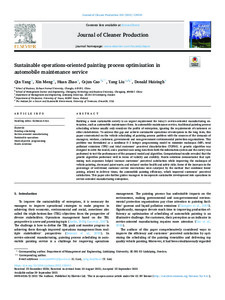Sustainable operations-oriented painting process optimisation in automobile maintenance service
Yang, Qin; Meng, Xin; Zhao, Huan; Cao, Cejun; Liu, Yang; Huisingh, Donald (2021-09-29)
Yang, Qin
Meng, Xin
Zhao, Huan
Cao, Cejun
Liu, Yang
Huisingh, Donald
Elsevier
29.09.2021
Julkaisun pysyvä osoite on
https://urn.fi/URN:NBN:fi-fe2022032224544
https://urn.fi/URN:NBN:fi-fe2022032224544
Kuvaus
vertaisarvioitu
© 2021 The Authors. Published by Elsevier Ltd. This is an open access article under the CC BY license (http://creativecommons.org/licenses/by/4.0/).
© 2021 The Authors. Published by Elsevier Ltd. This is an open access article under the CC BY license (http://creativecommons.org/licenses/by/4.0/).
Tiivistelmä
Building a more sustainable society is an urgent requirement for today's service-oriented manufacturing enterprises, such as automobile maintenance firms. In automobile maintenance service, traditional painting process scheduling scheme usually only considers the profits of enterprises, ignoring the requirements of customers or other stakeholders. To address this gap and achieve sustainable operations of enterprises in the long term, this paper concentrated on the vehicle scheduling of painting process problem with the concern of the demands of managers, workers, customers, governments and non-government environmental protection organisations. This problem was formulated as a nonlinear 0–1 integer programming model to minimise makespan (MP), total pollutant emissions (TPE) and total customers' perceived dissatisfaction (TCPDS). A genetic algorithm was designed to solve the model, and a practical case using data from both the information system and the survey was performed to test the performance of the proposed model and algorithm. Computational results revealed that the genetic algorithm performed well in terms of validity and stability. Pareto solutions demonstrated that optimising task sequences helped increase customers' perceived satisfaction while improving the makespan of vehicle painting, decreased paint waste, and reduced worker health and safety risks. Some of the increases in the percentage of well-timed customer service reservations were catalysed by the method that combined tiered pricing, related to delivery times, the automobile painting efficiency, which improved customers' perceived satisfaction. This paper also further guides managers to incorporate sustainable development into operations in service-oriented manufacturing enterprises.
Kokoelmat
- Artikkelit [2621]
